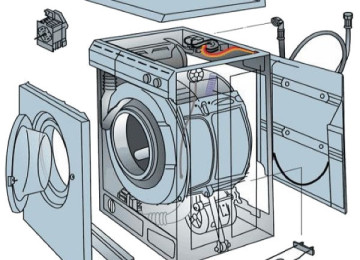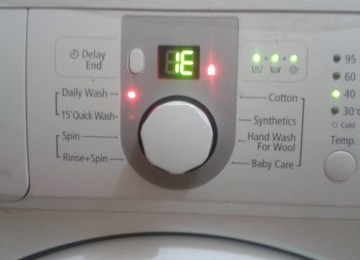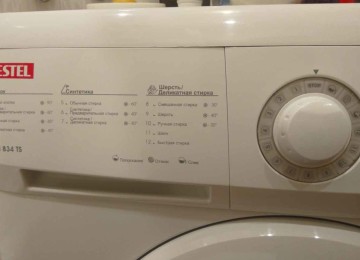A washing machine is a household appliance without which it is difficult to imagine modern life. Sooner or later it fails as a result of improper operation or power surges. Equipment breakdown requires an immediate solution to the problem, since washing is required regularly. If the washing machine is under warranty, repairs are carried out by the company providing the service.
After the warranty period expires, all problems related to restoring the device to working condition fall on the user’s shoulders. Most device breakdowns can be done by yourself. But how to disassemble a washing machine at home? To carry out repair work, you will need to familiarize yourself with the internal structure of the equipment, study the instructions, prepare the necessary tools, and purchase consumables.
Washing machine device
Before starting work, a technical diagram of the washing machine is studied, which clearly shows the structure of the equipment and the location of the connecting nodes, the location of the engine, electronic unit, control panel, etc. The standard device includes the following elements:
- Lid.
- Front Panel.
- Back wall.
- Control Panel.
- Tank.
- Drum.
- Electronic module.
- Inlet valve.
- Drain pump.
- Shock absorber.
- Pressostat.
- Powder tray.
- Heating element (heating element).
- Belt.
- Electrical engine.
Particular attention is paid to the study of the main components that most often fail. These include:
- tank ventilation;
- place of water inlet and distribution;
- WPS and WCS valves;
- control electronics (“brains”);
- drum imbalance sensor;
- counterweight location;
- fastening spring suspensions;
- heating element;
- ball valves;
- laundry load sensor;
- drum;
- door cuff;
- engine;
- shock absorbers;
- siphon, drain pump and filter;
- network shutdown;
- drum illumination (if equipped).
After carefully reviewing the instructions, you can begin preparatory work. If you have any questions regarding the repair process or the location of parts, it is recommended that you turn to online resources for help. The network is filled with a lot of videos from professional craftsmen who explain in detail the sequence of all actions, give recommendations, advice, reveal the secrets of the process, and point out the weak points of the equipment.
Preparing to disassemble the washing machine
Regardless of the brand of the washing machine, the internal design of the machines is similar for all models. Before you start disassembling, you should determine the place of work.An area of at least two square meters will be required. The room should be well lit. To prevent damage to the floor covering, the floors are covered with dense material, film or cardboard sheets.
It should be remembered that the machine is heavy with sharp corners, so linoleum can easily be pressed through, and laminate can be scratched.
Disconnecting the washing machine from the power supply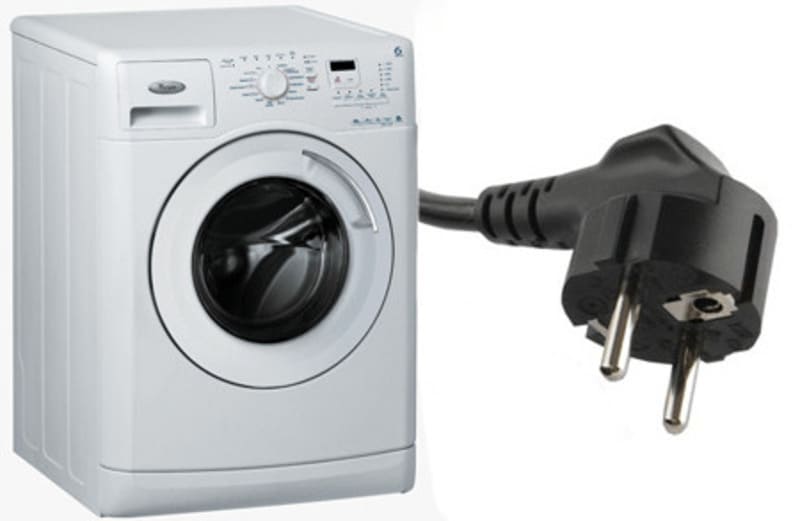
It is very important to turn off the power to the device. Do not disassemble the device while the power plug is connected. Any actions can lead to serious injuries to the technician, as well as damage to the washing machine. Safety precautions must be followed. After removing the plug from the socket, accumulated current may remain inside the appliance. You can check its presence using a special measuring device - a multimeter.
Turning off the water supply
To turn off the water supply from the main line, you must close the tap installed in front of the washing machine. Then disconnect the hose from the water supply fitting, fix the drain pipe in a vertical position on the body of the machine (you can use tape or special holding clips on the back panel of the body). The pull-out tray for detergents is removed, the filter at the bottom of the front part of the housing is unscrewed, and excess water is drained.
Preparing the necessary tools
Proper disassembly and removal of parts without damage is possible only with special tools. To work you will need:
- a set of Phillips screwdrivers with a long and small bit;
- screwdriver with bits;
- flat screwdriver;
- pliers;
- nut wrenches;
- hammer;
- multimeter;
- colored markers;
- lubricants WD-40, CV joint;
- Hydra-2 lubricant for oil seal and bearings;
- rags for cleaning dirt and cotton pads for degreasing.
If you need to saw a tank, you will need a drill, a hacksaw, a burr, a set of drills, a glue gun, a soldering iron, silicone sealant, self-tapping screws and bolts.
Note! Not all breakdowns can be fixed at home. Diagnosing and repairing an electronic device requires knowledge and skills. It is impossible to replace bearings if the tank is soldered without special tools.
Recording the sequence of disassembling washing equipment
During the process of disassembling the washing machine, it is recommended to take photo or video recordings so as not to forget the location of all the parts and where the colored wires are connected to the engine and electronic unit. Having captured the entire sequence, you don’t have to worry about the correct assembly of the equipment.
Disassembling a front-loading washing machine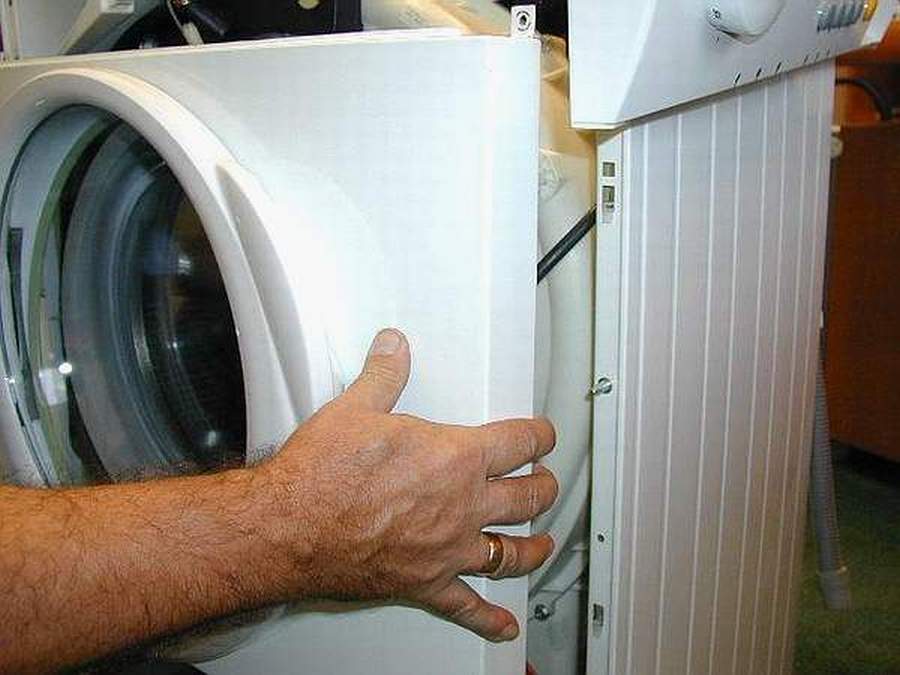
During the disassembly process, it is important to follow the sequence of dismantling parts. The following algorithm of actions is performed:
- The top panel of a front-loading washing machine is removed. Using a Phillips screwdriver, unscrew two press washers that secure the cover from the back. Then you should grab the edge from the front of the panel with both hands and pull it towards you. Care is required during the process so as not to break the fasteners made of plastic. The part should snap out and detach easily.
- The back cover is removed. Depending on the manufacturer and model, the mount differs. For a number of washing machines, the panel is fixed with small self-tapping screws around the entire perimeter, for others - with plastic latches (if the fasteners are firmly fixed, then you should slightly bend the fasteners with a screwdriver).
- The control unit is removed.Unscrew the screws at the top, sides and inside the detergent tray, then remove the part from the fasteners and secure it to the side of the unit (using service hooks, if any). If side fastening is not possible, then you will need to remove all the cables and disconnect the wires, having first fixed their exact location on the camera. You can mark each wire and its attachment point with colored markers.
- Remove the service panel. Unscrew the fixing bolts, pry the cover up and remove it using a flat-head screwdriver with a long bit. Remove the rubber cuff, which serves as a seal in the central part of the device. Use a screwdriver to pry up the clamp and remove it from the grooves. Then unscrew the screws holding the part, and remove the panel completely from the machine.
- Remove the hatch, and unscrew the two bolts that lock the door.
- Disconnect the heating element and the temperature sensor. Depending on the model, the heating element can be located in the front or back of the machine. To check the functionality of the part, you should completely pull the heating element out of the socket. Disconnect all the wires from both the heating element and the engine.
- Releasing the wiring. All conductors are connected with clamps and attached to the side wall. To check and make work more convenient, you will need to mark and fix the inputs and outputs of the wires in the photo, and then cut the ties and move the network to the side.
- Dismantle the counterweight. The machine design contains two counterweight elements, at the bottom and top of the body. To dismantle them, you will need to use a nut wrench.
- Remove the engine.The fasteners are unscrewed, the pulley is separated (unscrew one bolt in the central part) from the main part.
- The drain pipe is removed. The clamp is cut with pliers or wire cutters and the hose is released.
- Removing the tank. The last thing you can do is remove the tank. The washing mashine tilts on its side and the shock absorber mounts are unscrewed. Next, the washing machine is placed in its original position, and the tank is carefully removed from the retaining springs and removed from the unit body.
After disassembling and disconnecting all parts of the washing machine, you need to find the location of the breakdown. If the problem is inside the tank, then this element is disassembled. This is where home craftsmen often encounter a problem. Manufacturers of budget washing machine options install welded tanks on their devices, that is, non-separable tanks. This is done so that the user (even if he disassembles the washing mashine himself) buys a ready-made new tank from the manufacturer. But there is an option that allows you to eliminate additional costs and repair the existing tank - cutting the tank into two parts.
The process of dividing a soldered tank in half is quite complex and requires knowledge. It is very important to cut the part correctly and in the right place so that you can put the parts back together and prevent water leakage.
In service centers, craftsmen use two methods of dividing a welded tank:
- Cutting using a hacksaw.
- Cutting with a burr.
Regardless of your choice, it is very important to make the cut in the right place. For a more precise cut, first draw a bright line with a thin felt-tip pen. It should not fall on convex fragments of the tank or mounting bolts.Cutting with a hacksaw is a little faster, but it is difficult to maintain an even line (difficulties may arise when assembling the tank). The second option with a burr machine is the most successful, as it allows you to make a neat cut, without a torn edge.
Advice! Before you start sawing a soldered tank, you should evaluate your strengths and capabilities, because the most difficult job is to solder the tank to its original state.
After dividing the tank into two parts, the bearing assembly is removed. If necessary, the part is changed along with the oil seal. Hydra-2 is used as a lubricant, which additionally performs a water-repellent function.
After repairing all broken parts, reassemble in the reverse order. First the tank is soldered. In this process, you need to choose the most successful method. There are two options:
- gluing with gun glue (to do this, the gluing area is well degreased with alcohol, all interfering roughness is removed, then a continuous strip of adhesive from a hot gun is applied to the seam. The two halves are connected and left until the composition has completely hardened. Afterwards, the seam is lightly cleaned with fine abrasive sandpaper and thoroughly coated with silicone sealant);
- soldering with a soldering iron and plastic of identical characteristics.
Of course, the second option is more reliable, eliminating water leakage during operation. Therefore, it is recommended to use a solder connection. For high-quality soldering, you will need plastic identical to the one from which the tank is made. You can take it directly from the tank itself. Small pieces are cut off from a pair of protruding ribs (they do not perform a functional load, and their dismantling will not spoil the operation of the washing machine).
From the resulting pieces, strips are cut using metal scissors. Then the adhesion site is thoroughly degreased. The two halves of the tank are fixed so that there is no unnecessary movement of the part during soldering. Next, the soldering iron is heated up and applied to the seam to melt the joint and make a small groove in it, into which a pre-cut piece of plastic is immediately placed and soldered. The process is carried out along the entire perimeter. The work is quite painstaking and time-consuming. Therefore, you should be patient. After soldering the tank, the washing machine is assembled to its original state.
Disassembling a top-loading washing machine
Washing machines with vertical loading of laundry have other types of breakdowns. Most often, diagnostics reveal spontaneous opening of the snare drum. Corrosion of the metal block is often encountered, which also damages household appliances and leads to breakdowns of the moving unit during the washing process and the bearing unit during rotation of the drum.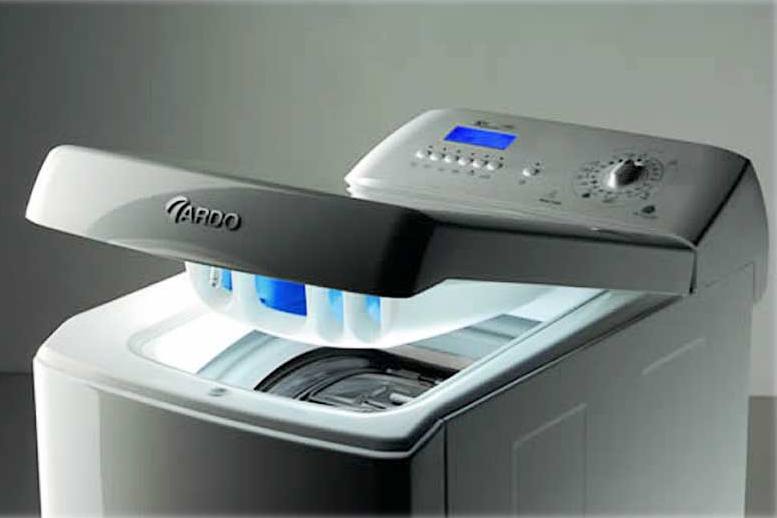
You should be aware that top-loading units often suffer from loss of elasticity of the upper door sealing rubber. As a result, its deformation is observed, after washing, puddles form on the floor, and rust appears on the body. To fix this problem, you will need to dismantle the control panel and replace the old seal with a new one. Then put the panel in place and check the functionality of the equipment.
Disassembling a top-loading washing machine has its own characteristics. Such equipment can also be repaired at home, subject to certain rules and safety precautions.
Before starting repair work, you should prepare a place for disassembly, disconnect the unit from the electrical networks, remove the water supply hose to the drum, and remove the drain pipe from the sewer.
During the disassembly process, residual water will leak out, so you should stock up on a rag and a basin.
To independently disassemble the washing machine, home craftsmen need to follow a certain algorithm of actions:
- The screws on the side walls of the device are unscrewed.
- The working unit is carefully moved towards itself, and all the wires are disconnected (after marking the input and output of each wire with a colored marker, and taking a photo of the original network).
- The control panel is dismantled.
- The top and side walls are removed.
- The fastening clamp is detached.
- Carefully, taking care not to damage it, remove the plastic casing.
During the process, it is very important to remember (photograph) the sequence of work and the place of attachment, the location of all parts, conductors and motor elements.
You can begin to repair and replace broken elements. Upon completion of the work, the device is assembled according to the reverse order of dismantling. After assembly, the functionality of the mechanisms is checked.
Features of disassembling washing machines of different brands
Washing machines produced by different brands have a similar structure, a basic set of internals, and identical parts. But their location inside the case varies significantly. This should be taken into account during repair work. To work correctly, you should know the intricacies of the models and the procedure for disassembling them.
LG
Household appliances from LG differ from their competitors in the complexity of their design.For example, to dismantle the front panel, you will first need to unscrew the mounting bolts using a key that secure the hatch cover. The screw that tightens the clamp and holds the rubber cuff is also removed. Only after this can you remove the upper weighting material, then remove the tank with the drum for repair or replacement.
The company's South Korean specialists have developed new models of washing machines, which are equipped with a self-diagnosis system. The unit itself displays the error number on the electronic display, which corresponds to the breakdown of a specific part. Now the user can assess for himself what is broken inside and whether he can fix the device at home.
Samsung
Household appliances from Samsung are quite easy to disassemble. But there are some nuances. The tray for loading powder can be removed only after unscrewing the two retaining screws. The heating element is located below the tank, right next to the panel, so removing it is not difficult. Otherwise, the disassembly process is identical to the standard scheme. The main thing is to follow safety precautions and record every step in the photo.
Electrolux
Washing machines from Electrolux are considered one of the most reliable. They are rarely seen in service. It is very simple to disassemble the case for diagnostics; just remove the front panel and all the main components, as well as some parts, will be visible to the technician. The equipment of the machine is important. The individual parts have their own working oil seals and bearings, so replacing them does not require completely disassembling the unit and removing the drum. This design greatly facilitates the maintenance of the household appliance.
Ariston
Most often, in models from Ariston, the bearings and oil seals on which the drum rotates fail. The design feature does not allow replacement of parts, which forces you to purchase a whole tank from the manufacturer. But skilled craftsmen can fix this damage too. Modern models are equipped with a self-diagnosis system, which makes it easier to identify faulty units. Deciphering the error code also allows you to understand the impending problem and eliminate it before it breaks down. Machines are dismantled in a standard manner. There are often models with a soldered tank, which makes repair work inside the drum difficult.
Atlant
The design features of Atlant machines make it possible to carry out repair work on any part without much difficulty. First, the counterweight is removed, then the upper control panel. The drum is assembled from two halves, which are securely bolted together. If it is necessary to replace bearings and seals, you only need to unscrew the bolts and separate the two parts. After collecting the tank, you should double check the quality of the connection between the two halves of the tank to prevent leaks during washing. While the tank is disassembled, the inside should be cleaned of fungi and scale.
Assembling the washing machine
Assembly is one of the important stages in the process of repairing a washing machine. It is important to correctly install all the parts, securely fix the fasteners, connect the control unit, connect the wiring and then check the operation of the device, including the heating element. To do this, the machine turns on to heat the water. In order not to run the equipment idling, you can load a couple of towels during the test wash.
Note! Before you start assembling the machine, you should clean all parts, rinse the drum, eliminate fungal and mold areas, and remove scale from the heating element.
Assembly is carried out in the reverse order of disassembly. Often the problem is placing the tank on the springs. If there is no assistant, then you can do it yourself only by securing the spring with wire in the upper part, and then tensioning it, moving counterclockwise.
When assembling top-loading equipment, special attention is paid to installing the rubber cuff. You need to make sure that it fits into the grooves and is locked in the right place on the hatch door. The triangle icon should correspond to the loading direction, and there should be a drain groove next to it. When tightening the bolts, it is important to ensure that they are at the level of the free brace pin.
The assembly of any model must be consistent and carried out with due care. If necessary, it is better to look at the photos taken once again before analysis.
Tips and recommendations from experts on disassembling a washing machine
Repair work on washing machines in service centers is carried out quite quickly, since the specialists already have enough experience and practice. At home, it is better not to rush and listen to the advice of practicing masters:
- During the process of dismantling the internal parts of the washing machine, you will notice that many elements are made of plastic. Therefore, during work, you should count on your strength and act as carefully as possible to prevent breakage of plastic products.
- During the work, it is recommended to make marks with colored felt-tip pens, for example, which wire is connected where.If a drum was sawed, a mark is made to prevent the halves from moving relative to the axis. Markings will help you avoid getting lost in a web of wires and save time.
- Despite disconnecting the device from the power supply, residual current may remain in the device and its individual parts. To check its presence and absence, a special device is used - a multimeter, which will allow you to accurately determine the charge level.
- Despite high-quality care of the washing machine, dirt accumulates under the cuff. Therefore, before installing the rubber seal, you should inspect the place where it is attached, and if necessary, clean the surface with chemicals.
- To make cleaning the heating element easier, you can use traditional methods without much effort. To do this, you need to immerse the part in water with citric acid and leave for 24 hours. After the time has passed, simply rinse the heating element in clean water. The scale will be easily separated from the copper tube. Descaling is carried out not only on heating elements, but also on other parts that interact with water.
- If fungus is found on the rubber cuff, powder receiving tray and other parts, it is better to resort to traditional methods - clean the elements using copper sulfate. To do this, dissolve half a teaspoon of copper sulfate in a liter of water. Using a spray bottle, the composition is sprayed onto all parts affected by the fungus. After an hour or two, the elements are washed with clean water.
- The work requires maximum accuracy. Do not make sudden movements or jerks, especially in the wiring areas. All cables must be carefully removed from the socket. Before installing them, pay attention to the integrity of the conductors.If a circuit break is found, soldering is carried out followed by insulation of the wire.
- Before starting work, a repair kit is prepared. If you plan to replace the bearing assembly and seals, you must first purchase them. Once everything you need is purchased, the assembly process will be much faster.
- You should not disassemble and reassemble household appliances yourself if they are under warranty, even if you have experience in repairing them yourself. The fact that the unit has been opened will be immediately detected, and they will refuse to repair it under warranty.
- You should not start disassembling equipment at home if you are not confident in the quality and correctness of your independent actions. In this case, it is better to contact specialists.
Don't rush during assembly. You should carefully think through and think about the operation process of the part that is attached inside the equipment. Incorrect assembly can lead to further and more serious damage to the washing machine.
Conclusion
It is not difficult to disassemble, repair and reassemble a washing machine. The main thing is to follow the sequence of work and safety precautions. If you have no experience in servicing household appliances, then a photo report is required. Do not forget to disconnect the device from the outlet, water supply and drain pipe. If you are not sure of a positive final result, then it is better not to undertake repairs, but to entrust the work to specialists.







